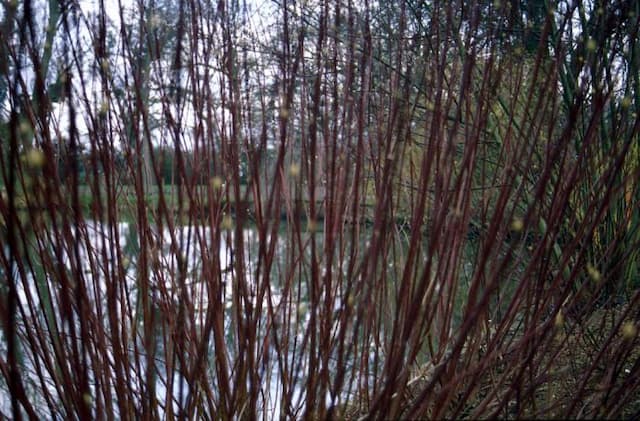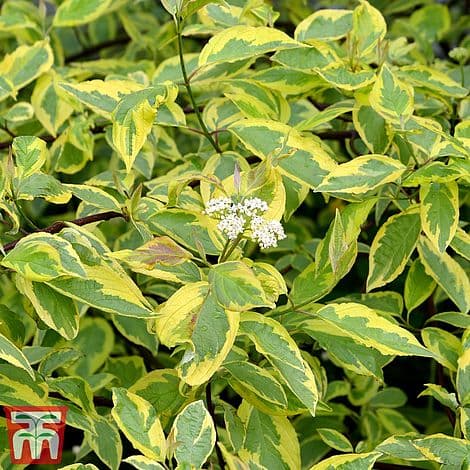Redtwig Dogwood Cornus 'Ormonde'

ABOUT
Cornus 'Ormonde' is commonly known as a type of dogwood. It is a visually striking plant that displays a variety of colors and textures throughout the seasons. This dogwood boasts a multi-stemmed appearance with branches that grow in a somewhat rounded fashion. The leaves are oval-shaped, coming to a gentle point, and provide a lush green backdrop during the warmer months. A distinctive feature of the Cornus 'Ormonde' is its ability to change color with the seasons. In spring, it produces vibrant flowers that bring splashes of color. These blooms are typically surrounded by modified leaves, often referred to as bracts, which may bear a resemblance to petals. As the months progress, the foliage undergoes a transformation, adopting fiery hues of red and orange as the weather cools, offering a warm, autumnal display. In addition to the eye-catching foliage, this dogwood also produces fruit that can add visual interest. The fruits are small and may range in color from a blue-ish to a more purple or black shade, attracting birds and wildlife. The bark of Cornus 'Ormonde' adds another layer of appeal with its textured and sometimes exfoliating qualities, giving the plant year-round interest even when the leaves have fallen. With its symphony of changing colors and a pleasing form, this dogwood is commonly used in landscaping to enhance the aesthetic of gardens and public spaces.
About this plant
 Names
NamesSynonyms
Ormonde Dogwood
Common names
Cornus 'Ormonde'.
 Toxicity
ToxicityTo humans
Dogwood species, which Cornus 'Ormonde' belongs to, are generally not considered highly toxic to humans. However, all plant parts may cause mild stomach upset if ingested in large quantities due to the presence of iridoid glycosides. Symptoms of dogwood poisoning might include vomiting, diarrhea, and dizziness. Care should be taken to avoid ingestion, especially by children who might be attracted to the fruit.
To pets
Dogwood, the general category to which Cornus 'Ormonde' belongs, is not typically known to be highly toxic to pets either. However, as with humans, the ingestion of large amounts of any part of the dogwood plant could lead to gastrointestinal upset in pets such as dogs and cats. Symptoms could include vomiting, diarrhea, and abdominal pain. It is always best to prevent your pets from eating ornamental plants as some may have varying levels of toxicity.
 Characteristics
CharacteristicsLife cycle
Perennials
Foliage type
Deciduous
Color of leaves
Varies
Flower color
Varies
Height
6-8 feet (1.8-2.4 meters)
Spread
6-8 feet (1.8-2.4 meters)
Plant type
Shrub
Hardiness zones
5
Native area
Asia
Benefits
 General Benefits
General Benefits- Ornamental Value: Cornus 'Ormonde', known as the Ormonde dogwood, has attractive foliage and flowers that enhance garden aesthetics.
- Seasonal Interest: It offers a variety of seasonal interest with flowers in spring, vibrant foliage in summer, and colorful berries and foliage in fall.
- Wildlife Attraction: The plant produces berries that attract birds and serve as a food source for local wildlife.
- Shade Tolerance: Ormonde dogwood can thrive in partly shaded areas, making it versatile for different garden designs.
- Drought Resistance: Once established, it can withstand periods of drought, reducing the need for frequent watering.
- Erosion Control: The root system can help stabilize soil and prevent erosion on slopes or banks.
- Low Maintenance: Requires minimal care once established, making it convenient for gardeners with limited time.
- Cold Hardy: It is capable of surviving in colder climates, which is beneficial for gardens in temperate zones.
 Medical Properties
Medical PropertiesThis plant is not used for medical purposes.
 Air-purifying Qualities
Air-purifying QualitiesThis plant is not specifically known for air purifying qualities.
 Other Uses
Other Uses- Cornus 'Ormonde', commonly known as dogwood, can be used in the creation of natural dyes, offering a range of colors from the bark and leaves.
- Its wood, being hard and dense, can be utilized in the manufacturing of tool handles or small, turned wooden objects requiring durability.
- Dogwood branches may also be used for weaving or making baskets due to their strength and flexibility when soaked.
- The fine-grained wood of dogwood is excellent for crafting detailed and intricate woodworking pieces such as inlays and marquetry.
- Fishing enthusiasts may find dogwood branches suitable for making traditional fish traps, thanks to their flexibility and endurance.
- With its vibrant seasonal colors and shapes, dogwood can be a valuable addition to educational projects and nature study activities for children.
- In historical woodworking, dogwood has been used for printer's blocks, due to its tight grain allowing for clear impressions.
- Photographers and artists sometimes utilize dogwood's picturesque branches and flowers as natural props or subjects for their work.
- During winter, the hardy dogwood can offer shelter and its berries can serve as a food source for local wildlife such as birds and squirrels.
- The compact growth habit of dogwood makes it an efficient choice for model landscapes, such as railway modeling and architectural mock-ups.
Interesting Facts
 Feng Shui
Feng ShuiThe Dogwood is not used in Feng Shui practice.
 Zodiac Sign Compitability
Zodiac Sign CompitabilityThe Dogwood is not used in astrology practice.
 Plant Symbolism
Plant Symbolism- Stability - The dogwood, known for its sturdy wood, represents stability and strength, reflecting its ability to withstand various conditions.
- Faith - Because of its cross-shaped flowers, the dogwood has been associated with Christianity and symbolizes faith and endurance.
- Resilience - Dogwoods are known for their resilience against pests and diseases, symbolizing the ability to overcome adversity.
- Renewal - The dogwood's prolific spring blooms symbolize rebirth and new beginnings, often associated with the Easter season.
- Innocence - The pristine appearance of the dogwood flowers is often connected to purity and innocence, evoking a sense of simplicity and virtue.
 Water
WaterThe Pagoda Dogwood, which is the common name for Cornus 'Ormonde', prefers evenly moist soil and should be watered deeply once a week, providing about 1.5 gallons of water each time. During hot and dry spells, watering frequency should increase to twice a week. It's important to avoid letting the soil dry out completely but also to prevent waterlogging as it could lead to root rot. Adjust watering routine according to the season and local weather conditions. Overhead watering is not recommended as it can lead to foliar diseases - instead, water directly at the base of the plant.
 Light
LightThe Pagoda Dogwood thrives in a spot with partial shade to full sun. Ideal conditions include morning sunlight with afternoon shade to protect it from the intense heat of the day. The plant can also tolerate full sun in cooler climates, but in hotter regions, more shade is beneficial to prevent leaf scorch.
 Temperature
TemperatureThe ideal temperature range for the Pagoda Dogwood is between 60°F and 75°F, though it can withstand temperatures as low as -20°F and as high as 90°F. However, for optimal growth and health, maintaining a temperature within this range is best. Temperature extremes should be avoided as they can stress the plant.
 Pruning
PruningPrune the Pagoda Dogwood in late winter or early spring before new growth starts to remove any dead or damaged branches, to maintain its shape, and to encourage healthy growth. Thinning out the canopy every few years allows light and air to penetrate the plant, which reduces the risk of diseases. Regular pruning also helps to stimulate flowering and to preserve the Pagoda Dogwood's distinctive architecture.
 Cleaning
CleaningAs needed
 Soil
SoilDogwood 'Ormonde' thrives in a well-draining, fertile soil with a pH of 5.5 to 6.0. The best mix can be achieved by blending garden soil with compost and a bit of sand or perlite to improve drainage.
 Repotting
RepottingDogwood 'Ormonde' doesn't require frequent repotting. Young plants can be repotted every 2-3 years, while mature specimens may only need repotting every 4-5 years.
 Humidity & Misting
Humidity & MistingDogwood 'Ormonde' prefers moderate to high humidity levels but is adaptable and can tolerate a range of humidity conditions typical of outdoor environments.
 Suitable locations
Suitable locationsIndoor
Provide bright, indirect light and keep soil moist.
Outdoor
Plant in partial shade, mulch well, and protect from harsh winds.
Hardiness zone
5-9 USDA
 Life cycle
Life cycleCornus 'Ormonde', commonly known as Ormonde Dogwood, begins its life as a seed, which germinates in early spring under favorable conditions such as moist soil and adequate light. The seedling emerges and develops into a young sapling with a basic root system and leaves. As the sapling matures, it grows into a small tree with a more extensive root system and woody stems, producing distinctive foliage and, eventually, flowering in late spring to early summer. After pollination, typically by insects, the flowers develop into small, berry-like fruits by late summer or early fall. These fruits are then dispersed by birds and animals, allowing for seed distribution and the potential growth of new plants. The Ormonde Dogwood concludes its life cycle when it reaches senescence, a stage characterized by reduced vitality and productivity, until it eventually dies, completing the cycle.
 Propogation
PropogationPropogation time
Spring-Early Summer
The Cornus 'Ormonde', commonly known as the Ormonde Dogwood, is typically propagated by semi-hardwood cuttings. This popular method involves taking cuttings from the current year's growth during the late summer or early fall, after the stem has begun to harden but is not yet fully mature. The cuttings, about 4 to 6 inches long, with a few leaves left on the top, should be taken from healthy branches. Dip the cut end in a rooting hormone to encourage root development, then plant the cutting in a well-draining soil mixture. It’s essential to maintain a humid environment for the cuttings, often achieved by covering them with a plastic bag or using a misting system. The cutting will usually root in a few weeks, at which point it can gradually acclimatize to less humid conditions before transplanting.









